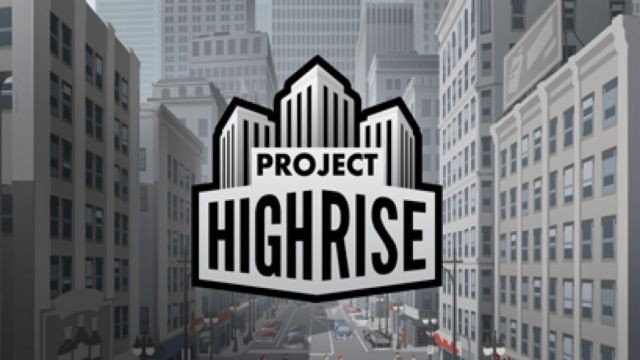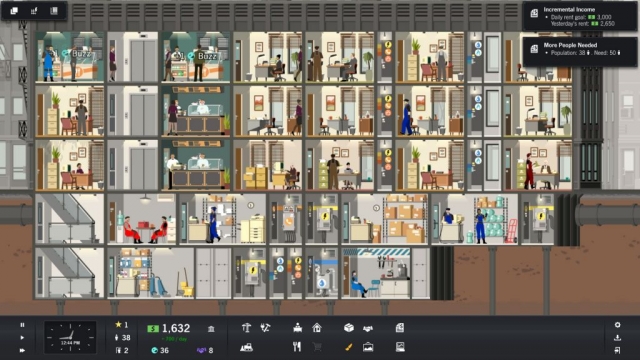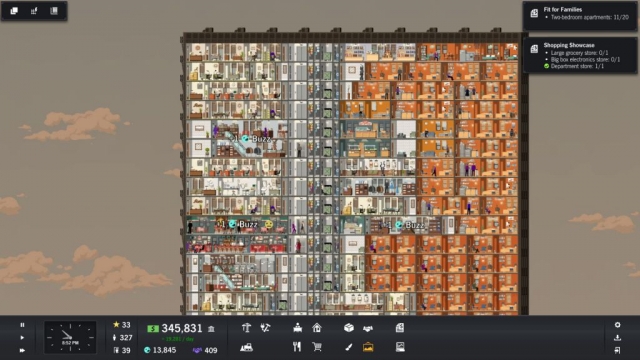Project Highrise

Project Highrise is a new skyscraper construction / management game from Chicago-based developer SomaSim. In it, you start out with a simple two-story building, and you expand it upwards, downwards and sideways so you can add a variety of businesses and apartments — and hopefully make a lot of money. But is it fun to play, or would you be better off watching paint dry? Keep reading to find out.
In Project Highrise, businesses and apartments are placed on the above-ground levels of your building. These structures come in a variety of shapes and sizes, and they also have a variety of requirements. The simplest / tiniest restaurants, offices, stores and apartments can go right in, provided you supply them with basic utilities like electricity and water. But as you make your way to gourmet restaurants, corporate headquarters, and luxury suites, the requirements grow. You might have to add security, janitorial services, copy centers, and even dog walkers to keep your businesses and residents happy. These services all go in the basement levels.
The focus of the game is on money management. Each business or resident you bring in has to pay rent, but this is offset by the upkeep for the services you provide. So you have to decide, for example, if adding a resident who wants a dog walker is worthwhile, if nobody else in the building wants one. Services can support numerous businesses and residents, so the more overlap you have, the better. To help you out with money, you can also sign “contracts.” These are essentially random objectives (like collecting a certain amount of rent money, or having a certain population in your building), and when you complete them you’re awarded money.
Along with money, there are three extra resources. Happy visitors in your building generate “buzz,” which you can spend on temporary bonuses. These bonuses include things like happier workers, lower maintenance, and extra visitors. You can also earn “influence” from the workers and residents in your building. With enough influence, you can hire consultants and unlock new services and structures. For example, one of the consultants is an interior decorator, who allows you to add paintings and sculptures to your hallways. And finally there is “prestige.” You earn this mostly by increasing the population of your building, but you can also get some from adding artwork and keeping residents happy. The higher your prestige, the ritzier the businesses and apartments you can add.
At this point, Project Highrise probably sounds like most other sim games because your objectives are the same — you’re trying to keep people happy while also making money. But sadly Project Highrise has some major flaws that just about kill it. The first is that your building has zero personality. You’re not allowed to choose the size of any of the businesses or apartments, or decorate them in any way; the businesses have generic names and they all look about the same, so they’re tough to tell apart; and the people just trudge through their daily lives without any emotion. So if somebody leaves your building because they’re unhappy, you can just rent out their space to somebody else, and there isn’t any difference whatsoever. This isn’t the sort of game where you’re going to form an attachment to any of your residents, or watch what they’re doing, or wish you could name them.
The second flaw in Project Highrise is that it focuses completely on money management, but the management isn’t very complicated. As long as you keep your rent total higher than your upkeep total, you win. That might sound like an obvious statement that’s true of all sim games, but in Project Highrise you know just how much everything is going to cost, and you don’t have to add anything if you don’t want to. There aren’t any time limits for anything, so if your building is in a state where you’re making money, then you’re going to continue making money forever, and you can just wander off for an hour while you build up a war chest for your next expansion.
Finally, Project Highrise is only a sandbox game. You’re allowed to build however you want for as long as you want, until you meet a trio of objectives (for scenarios) or until you get bored (for the main game). I think the developers would have been better off creating a campaign of some sort where you start out with an empty building and have to fill / manage it in the “right” way to win. Then the game would have some puzzle elements and extra strategy, which it desperately needs.
In my first game of Project Highrise, I used the default difficulty setting, which was a mistake. In that game I started making money faster than I could spend it — literally — and there wasn’t any challenge at all. Still, I wanted to see as many game elements as possible, so I kept expanding until I reached the 40th floor, but by that time I was so bored I would rather have been doing anything else. So I started a new game at the next higher difficulty setting, and that worked better. The finances were tighter, forcing me to plan ahead more, but I still didn’t have any fun playing. Project Highrise is just dull. It really needs fires or burglaries or just about anything to break up the monotony.
And so overall, I didn’t enjoy Project Highrise very much. I played for about 10 hours total, and it was a chore. The game doesn’t look good, nothing interesting happens while you’re playing, and the strategic elements are minimal. I’d only recommend the game to you if you’re suffering from insomnia, and you need an alternative to warm milk or counting sheep. Project Highrise might put you right to sleep.
Reviewed By: Steven Carter
Publisher: Kasedo Games
Rating: 58%
——————————————————————————–
This review is based on a digital copy of Project Highrise for the PC provided by Kasedo Games.
 Game Over Online
Game Over Online











I think this review is pretty spot on.
Fans of PH like to say “don’t expect SimTower, because it isn’t”. But it really *should* have taken a few pages from SimTower’s gameplay, which was far more entertaining and engaging. Earning a star in SimTower actually felt like you had accomplished something. Working towards that 2-star rating, with 300 population, was a daunting task as a new player to the game. PH gives away prestige like candy on Halloween.
The Stairs/Elevators taking up physical space in your tower really detract from the whole experience, too. Horizontal accommodations are already pretty tight in comparison to what you had in ST (especially considering the utilities you need on each floor in PH such as trash, recycling, and power & janitorial closets), but to then realize you cannot add Stairs or a 2nd elevator shaft after the fact, for example to compensate for the quite frankly too-often occurrence of an elevator breakdown, is quite annoying.